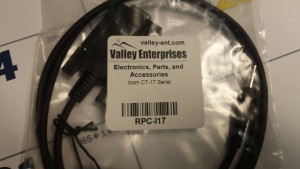First, let me say that, although I have made all the physical connections, I have not yet configured RemoteRig for use with the Code Warrior paddles. Free time has not yet manifested in the proper form 🙂
I will actually have a couple of related projects to complete, all of which is intended to make HF operating easier, and maybe I can get them all done at the same time.
CI-V is what Icom calls their protocol for computer controlling their products. It is an initialism for Communications Interface V (as in 5). There was/is a CI-IV, implemented most notably in the IC-751 transceiver, but almost every transceiver and receiver since then offers connectivity via CI-V. The two are not electrically interchangable, but there exists a CI-IV to CI-V converter and CI-V has backward compatibility with the data protocol of CI-IV.
Fundamentally, CI-V is a multidrop half duplex serial data protocol and command set. Electrically, it is a single wire for transmitting and receiving data and a ground or return, with logic levels of 0v and 5v. Bitwise, the protocol is compatible with a (once standard) PC serial port, though it must use a level conversion chip. RS/EIA-232 is a +/- 12v protocol. Also, since transmit and receive are shared on a single wire, a diode or some such needs to be in line to isolate the transmitter output of each device on the line from the other devices.
Most or all that is taken care of for us in the Icom CI-17 interface or it’s compatible clones.
There are two common cables. One has a USB serial port and all the necessary wiring and drivers needed to connect a PC or laptop directly to the transceiver. The other is a DB-9 serial to CI-V cable which has the level conversion circuitry built in. Since the RemoteRig implements a DB-9 serial port from one end to the other, it is this cable that I need and have indeed procured.

There are two main reasons I want to implement CI-V in my setup.
One of the handiest things logging software can do is automatically log your frequency and mode, which it can do by knowing what your rig is currently running, via computer control. Because RemoteRig inserts a configurable bit of hardware in the middle of that chain, I may need to dink with it a bit to get it operational, but I should be able to plug my laptop into the Control-RRC and use the CI-V protocol to talk through the LAN/WAN to the Radio-RRC and on to the physical radio. Not only can that help in logging, but I can also do other rig control functions.
The other big thing is RemoteRig’s alternate control clients.
RRC-Micro PC-Client is a small hardware device that lets your PC do remote rig control over WAN/LAN while it takes care of the SIP audio streams and PTT. Operating thusly, you can leave the comparatively bulky Control-RRC, radio control head and speaker at home and work completely from a laptop, say from a hotel room while travelling for business.
If your laptop is too big, try using your Android telephone or tablet and the RRC-Nano App. It implements a light version of rig control (with brand-specific versions of the app) and the Android device does the audio, too.
In the case of the IC-706mkIIg, the CI-V implementation in that model (and others) doesn’t doesn’t support power on/off. To prepare the radio for remote operation with either of those clients, put the control head back on the radio and leave it powered up. When either client connects, the radio will respond to CI-V controls and the Radio-RRC takes care of the remote communications and audio.
That’s the design, anyway.